SUBJECT: Journeyman Pipefitter Dies When Struck in Chest While Removing Vic Fitting End Cap From a Pressurized Pipe
Michigan Case Report: 06MI201
Summary
On December 13, 2006, a 41-year-old male plumber/pipefitter died when he was struck in the chest by a pipe cap that he was removing from a pressurized pipe. Some leaks had been identified in an 8-inch waterline that had been previously installed and which needed to be repaired. To aid in troubleshooting the leak locations, valves were closed off in the lines, creating sectionalized portions of air charged waterline. The waterline was pressurized to 80 psi. After pipe repair was completed, the air was released from the lines, except for a portion “downstream” of a closed valve, which left a section of line still pressurized to 80 psi. At the end of the 8-inch line, there was a vic fitting end cap (also referred to as a victaulic, groove lock or gasketed end cap). The decedent was removing the 25-pound vic fitting end cap from the 8-inch line in the main boiler room in preparation for continuing the waterline project. The metal cap struck the decedent in the neck and upper chest area when it blew off the end of the pipe. Fellow workers called 911. Emergency response arrived, and the decedent was taken to a local hospital where he was declared dead.
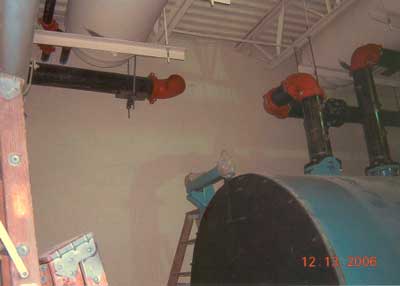
|
|
Figure 1. Incident scene
|
Recommendations:
- Employers should ensure that their written accident prevention plan identifies and describes all hazards that could be encountered in the worksite and how to recognize and avoid them.
- Employers should develop a specific standard operating procedure for pipe pressurization/depressurization including securely tagging appropriate piping and pipe components, such as caps, plugs, valves, etc.
- Employers should use an end cap that remains attached to the pipe during loosening and prior to removal, or outfit the end cap with a pressure-relieving device.
- Employers should periodically reinforce skill and safety training.
Introduction
On December 13, 2006, a 41-year-old male journeyman pipefitter was killed when a threaded pipe end cap under pressure struck him in the neck/chest area. On December 13, 2006, the Michigan Occupational Safety and Health Administration (MIOSHA) personnel received the fatality report on their 24-hour-a-day hotline. Later that day, MIOSHA personnel notified MIFACE. The MIFACE researcher interviewed the company’s safety and fleet manager on May 23, 2007. The company representative shared the firm’s standard operating procedure for pressurizing/depressurizing pipes (Appendix A) developed after the incident and several black and white pictures of the incident site. During the course of writing this report, the death certificate, medical examiner’s report, police report and MIOSHA file and citations were reviewed. The picture used in Figure 1 is courtesy of the responding police department. The pictures used for Figures 2, 3, and 4 are courtesy of the MIOSHA compliance officer.
The company is a mechanical contractor, performing electrical, heating, cooling, piping and state of the art automated control systems for commercial construction. The decedent had worked for the company as a full-time employee for eight years. He was one of 20 journeyman plumber/pipefitters in the company, which employed 160 individuals. The decedent worked eight-hour days and had been on this jobsite for approximately two months. The company had a health and safety program but did not have any specific standard operating procedures related to pipe pressurization/depressurization at the time of the incident. The safety/fleet manager was responsible for the safety program, including providing safety training and maintaining safety training documentation. The firm has a health and safety committee composed of the safety/fleet manager, a human resources representative, a service coordinator and two employees who work primarily in the field. The health and safety committee meets monthly. The safety/fleet manager visits all jobsites on a regular basis and conducts safety meetings while at the job site. The firm has a written disciplinary procedure for safety and health policy violations.
At the conclusion of their investigation, MIOSHA Construction Safety and Health Division issued the following Serious citations to the company:
- GENERAL RULES, PART 1, RULE 114(2)(d): Employees not trained or instructed to recognize hazards with working with pressurized airlines and associated equipment. No procedures were in place to eliminate exposure to hazards associated with pressurized equipment. Employees were exposed to hazards connected with pressurized equipment and its uncontrolled release of energy
- GENERAL RULES, PART 1, RULE 127(3): Residual, stored energy was not released from pressurized lines prior to the employee resuming the work operation. Employee was working on piping and exposed to injury from uncontrolled release of air pressure, and subsequent flying material and equipment.
Investigation
December 5, 2006
The decedent, a journeyman pipefitter, and his crewmembers, two apprentice pipefitters, had been installing 6- and 8-inch waterlines at a new high school between the second floor Mechanical room and the first floor Boiler room. After a portion of the lines had been installed, the lines were capped and sealed off, and then pressurized to 80 psi with compressed air to allow leaks in the lines to be identified prior to them being filled with water. The decedent and one of his coworkers conducted a pressure test on the piping. When the lines were pressurized, the decedent heard air leaks in the Mechanical room. The decedent closed a “steering wheel” butterfly valve in the Mechanical room on the second floor to stop the pressure from leaking out from the second floor mechanical piping (Figure 2). After repairs were made, the line was recharged, and the field foreman for the decedent’s employer and the construction manager for the project completed a test report to verify that the lines were free of leaks. After the construction manager signed off on the form that the lines passed inspection, the field foreman told the decedent to release the pressure off all the piping. Air was released from the pipes, except for a portion of line “downstream” of the closed valve. This section of line was left pressurized to 80 psi. The reason for this is unclear. Pressure was released in the Boiler room, and the gauges that had been set up in the Boiler room read zero. It appears that after the successful pressure testing of the piping, the decedent did not go back to the second floor Mechanical room to open the valve that he had closed.
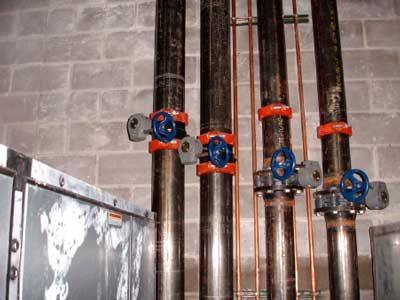
|
|
Figure 2. Valves in lines in Second Floor Mechanical Room
|
Day of Incident
For a week after the pressure testing, the decedent and his coworkers were running pipes to the boiler. The decedent had been working in several buildings at the construction site over the past several months. On the day of the incident, the decedent and his coworkers arrived at the job site at approximately 5:30 a.m. after a two-hour drive from their home. The crew began working at 6:00 a.m. in the Boiler room.
After arriving in the Boiler room, the decedent and his coworkers hung a 14-foot long 6-inch diameter pipe. The decedent then instructed the two apprentice pipefitters to finish putting a valve and a shorter “pup” piece on the line and to tie it into the boiler. The decedent stated to his coworkers that he was going to configure the run for the 8-inch pipe that was located approximately 12 feet from the floor. At the end of the 8-inch line was a vic fitting end cap that had to be removed. The cap that was used is also known as a groove lock cap, or gasketed end cap. These names describe a method of isolating a pipe that consists of bolting a coupling with a gasket in which the cap or plug is seated onto the end of the pipe by a two-piece clamp with a nut and bolt on each side. The incident occurred while the decedent was removing the 25-pound vic fitting end cap from the 8-inch pipe. While loosening the cap clamp, the cap blew off the end of the pipe, striking the decedent in the neck and upper chest area. It is unclear from the photos if the decedent was straddling a 10-foot ladder, standing on the top step of the ladder, or standing on top of the boiler, which was close to the capped pipe. It is also unclear if the decedent was directly in line with the end cap or if the cap blew off at an angle other than parallel with the direction of the pipe run.
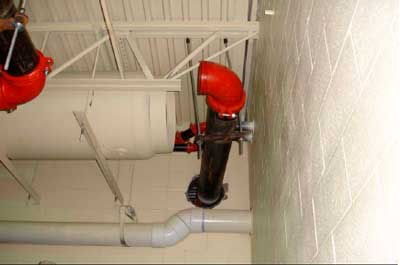 |
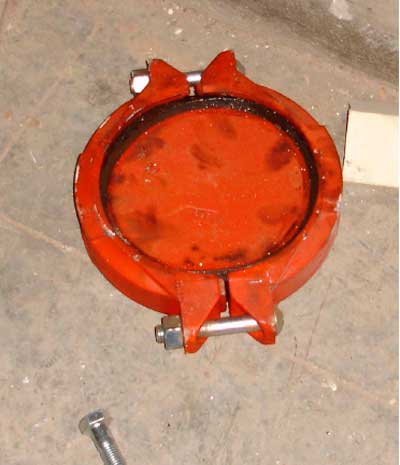 |
|
Figure 4. End cap that struck decedent
|
None of the coworkers in the Boiler room actually saw the incident occur. Hearing a noise, they moved from their work area and found the decedent on the floor approximately 15-20 feet away from the end of the pipe. The end cap was found on the floor approximately seven feet from the decedent. The wrench the decedent was using to loosen the clamp was found caught between the boiler and its associated piping. One of the coworkers called 911. Emergency response arrived and transported the decedent to a local hospital where he died.
Prior to the MIFACE interview, the company developed and distributed to all involved employees a pressure piping testing procedure and “lock out tag out” procedures for the testing. The procedure included a Pressure Test Form that must be signed off by two company employees. The company’s written procedure is included as Appendix 1.
NOTE: The written procedure has been amended to address the potential issue of multiple crews working on a line. These additions are noted in the document by italics.
Back to Top
Recommendations/Discussion
Employers should ensure that their written accident prevention plan identifies and describes all hazards that could be encountered in the worksite and how to recognize and avoid them.
At the time of the incident, none of the employees had been trained in the area of working around pressurized piping and the recognition of potential hazards associated with the release of residual energy. In this case the employer did have an accident prevention plan, but the plan did not include a procedure for ensuring that the pipe had been depressurized. At a construction site where it is not possible or appropriate to observe skilled tradesmen constantly, an accident prevention program that identifies and describes the potential hazards to be encountered during the work serves to highlight and reinforce information that the workers bring to the job. Why the pressure had not been bled off the line will never be known. A reminder regarding the procedures at the beginning of the project as part of the accident prevention plan, however elementary it might have seemed to the workers, might have prevented this incident.
Employers should develop a specific standard operating procedure for pipe pressurization/depressurization including securely tagging appropriate piping and pipe components, such as caps, plugs, valves, etc.
After the incident, the company developed the standard operating procedure attached as Appendix 1. Affixing tags to the line and line components is a convenient way to identify that the line/line components are pressurized. The fluorescent ribbons described by the company can be seen and identified by all workers at the site. MIFACE has a concern that if the ribbons are not securely affixed, other site workers could be remove them. MIFACE recommends that the standard operating procedure be revised to use a tagging method that ensures the tags will not be removed except by the authorized workers that applied them.
Employers should use an end cap that remains attached to the pipe during loosening and prior to removal, or outfit the end cap with a pressure-relieving device.
A threaded fitting may allow a worker to hear air escaping from the fitting, but with the “vic” end cap, the cap is clamped down on a groove in the pipe. When a vic clamp is loosened from the groove, a worker does not have time to accurately determine how loose the cap is or to hear air escaping before the cap releases from the groove. The company’s procedure now requires “installing a tee in place of a 90-degree elbow, or use of a tapped cap or plug with a valve. A boiler drain, coin vent, or a small ball valve, can then be installed to relieve pressure after a test has been successfully completed.” The employer could also consider using an end cap that remains attached to the pipe during loosening. Whichever method is used to guard against a cap exploding from the end of a pressurized line, the most important control is to make every effort and plan to ensure the line is depressurized before removing any end piece.
Employers should periodically reinforce skill and safety training.
According to a journeyman pipefitter, apprentice and journeymen pipefitters are taught always to walk down a piping system and open any drains or vents to ensure the line they are penetrating has no pressure on it. Familiarity with a task often leads to a lax attitude regarding the steps to be followed to perform a job safely. Reinforcement of safety training serves to remind experienced workers that they can never become complacent. Appropriate consideration given to the type and value of the training can also indicate to the workers that working safely is viewed as an important element of the job and safety is not simply being given lip service.
References
MIOSHA Standards can be directly accessed from the Michigan Department of Labor and Economic Growth, MIOSHA websiteexternal icon www.michigan.gov/mioshastandards. The Standards may also be obtained for a fee by writing to the following address: Michigan Department of Labor and Economic Growth, MIOSHA, MIOSHA Standards Section, P.O. Box 30643, Lansing, Michigan, 48909-8143. MIOSHA Standard Section phone number is (517) 322-1845.
- MIOSHA Construction Safety Standard, General Rules, Part 1.
- MIFACE Investigation #02MI090: Journeyman Pipefitter Killed When Struck in Head by Grooved End Cap under Pressure. Internet Address: http://www.oem.msu.edu/MiFace/02MI090v1.pdf
Michigan FACE Program
MIFACE (Michigan Fatality Assessment and Control Evaluation), Michigan State University (MSU) Occupational & Environmental Medicineexternal icon, 117 West Fee Hall, East Lansing, Michigan 48824-1315. Internet Address: http://www.oem.msu.edu/MiFACE_Program.aspx. This information is for educational purposes only. This MIFACE report becomes public property upon publication and may be printed verbatim with credit to MSU. Reprinting cannot be used to endorse or advertise a commercial product or company. All rights reserved. MSU is an affirmative-action, equal opportunity employer. 10/16/07 (Link updated 8/5/2009)
MIFACE Investigation Report # 06MI201 Evaluationpdf iconexternal icon (see page 7 of report)
To contact Michigan State FACE program personnel regarding State-based FACE reports, please use information listed on the Contact Sheet on the NIOSH FACE web site Please contact In-house FACE program personnel regarding In-house FACE reports and to gain assistance when State-FACE program personnel cannot be reached.
APPENDIX A
PRESSURE TESTING STANDARDS
- These standards will apply to all piping material whether it is copper, threaded, welded, victaulic or pex tubing and/or any other applicable type of material used in our industry.
- Every section of piping must have a means of relieving air pressure prior to removing a cap or plug. A section of piping would be, any point between caps, plugs or any valve, which is capable of holding pressure. This can be done by installing a tee in place of a 90-degree elbow, or by using a tapped cap or plug with a valve and then installing a boiler drain, coin vent, or a small ball valve, to relieve pressure after a test has been successfully completed. Pressure relief ports may be used as a test port providing it is tagged with a yellow ribbon and has an approved valve or vent.
- Before any pressure testing is to take place, employees place fluorescent yellow marking ribbons on all pipe caps, plugs, service valves and bleed valves before testing is going to take place. This will include all plumbing, hydronic, gas, process and refrigerant piping. Sections being tested must also have at least one accurate pressure gauge installed at the point where air pressure is being introduced to the system. This gauge must be easily accessible from the ground.
- After all relief valves and yellow ribbons have been installed, at least two employees must sign off that the standards have been met. By signing off, employees are confirming the system is ready to be pressurized.
- After piping has been successfully tested on that specific section of pipe, the first valve to be opened shall be the valve where the system was pressurized from. Then employees must verify all service and relief valves are open. Once all residual pressure is released from the system and all valves have been opened, the employee may then remove the ribbon from the piping. If for any reason that section of piping must be retested, all ribbon must be reinstalled prior to repressurizing the system.
- Before any cap or plug is to be removed, at least two employees working on installing that system must verify that all pressure bleed valves and service valves have been opened to ensure the system is not under any pressure. This will require physically exercising all valves. When valves have been proven open and ribbon removed, employees may then sign off on the pressure test sheet to document that all standards have been met.
- General Rules
- Never stand or allow anyone to stand directly in line with a cap or plug being removed
- Always assume that pipe is under pressure until you prove to yourself otherwise
- Always communicate to your fellow employees what lines are under testing. Multiple crews may be testing the same lines at different times overall coordination and control of pressure testing is required to be overseen by a supervisor or company representative on site.
- Any employee not following these standards may be immediately sent home and receive one day off unpaid for the first offense. Second offense will receive three days off with no pay. Third offense will be termination of employment.
All associated lock-out/tag out procedures will be in accordance with MIOSHA Construction Safety Standard Part 1,Rule 127,
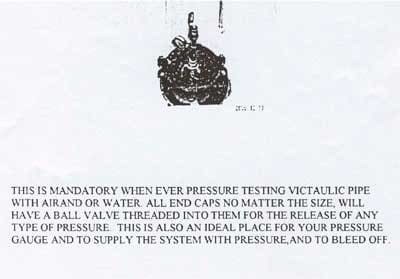 |
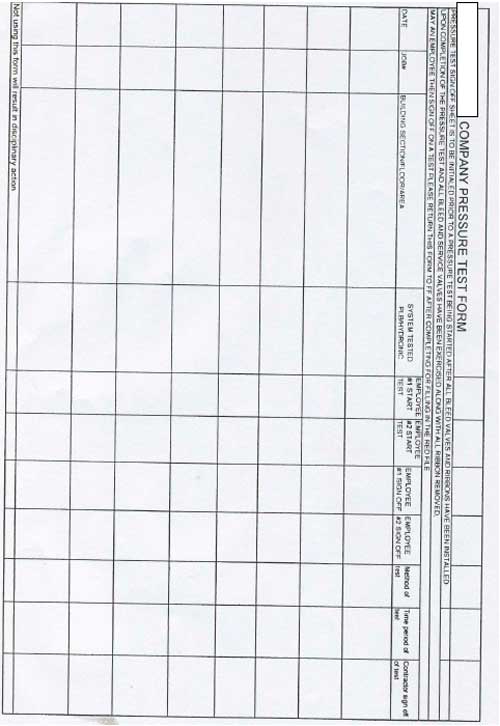 |
